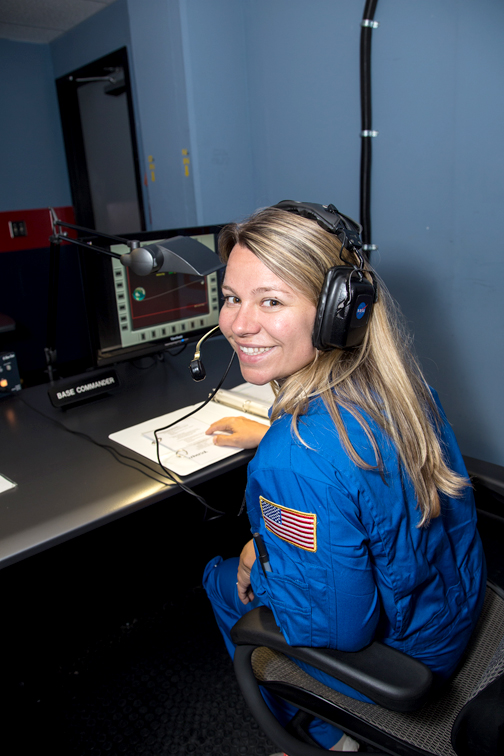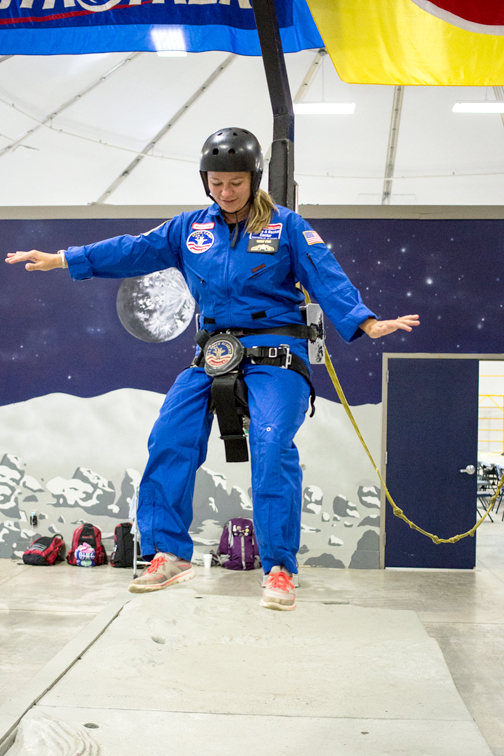Math teacher Paula Jackson shares her experiences at Space Academy.

Wilson Middle School teacher Paula Jackson gives a thumbs up in the flight simulator during the Honeywell Space Academy. Jackson went through the academy program to bring information back to encourage her STEM students.
By Mary O’KEEFE
Imagine being an astronaut floating in space, or in mission control dealing with data being sent down from the space station. For a local teacher and about 100 of her colleagues, this was how they spent their summer vacation.
La Crescenta resident and Wilson Middle School math teacher Paula Jackson just returned from a trip to the Honeywell Space Academy.
“We were able to do so many things,” Jackson said.
Teachers from the U.S. and other countries joined together to learn what it would be like to be an engineer, scientist or space explorer.
“We were put on teams of [about] 15,” Jackson said. “The first thing we did was just talk and meet each other.” Then it was time to get to work.
The teams experienced what it would be like to be part of a space exploration program.
“We were in a flight simulator to a space station [with other scientists] with one [person] flying the controls,” she said of one of the scenarios.
Another was simulating being in mission control reacting to real life situations that face those in the fields of science, technology, engineering and mathematics (STEM).
“It gives you an appreciation for … how things work,” she said.
Honeywell Educators @ Space Academy was created in 2004 by Honeywell and U.S. Space and Rocket Center.
“There was an issue with teachers learning STEM. What we wanted to do is take the teachers into real life situations,” said Kerry Kennedy, director of Honeywell Hometown Solutions.
Honeywell Hometown Solutions is the company’s corporate social responsibility initiative that created the program.
Since its beginning, over 2,000 math and science teachers have participated in the program.
According to the U.S. Dept. of Education, the U.S. is falling behind internationally in STEM studies ranking 25th in mathematics and 17th in science among industrialized nations. Only 16% of American high school seniors are proficient in mathematics and interested in a STEM career. Only 46% of California eighth graders scored proficient or above the state assessment in math in the 2011-12 school year.
It is these statistics that inspired Honeywell to create the space academy program. Jackson learned of the program from a fellow teacher.
“Another teacher, Mary Inglish, raved about it,” Jackson said.
The Wilson teachers have participated in other NASA activities including being part of a NASA Explorer teachers program.
The value of the Space Academy lies not only in its hands-on activities but also in how all the experiences and new knowledge can be brought back to schools and shared with other educators who in turn share with students. Jackson, for example, is a math teacher who works closely with Wilson science teachers who in turn can share her experiences with their students in the classroom.
Jackson also uses what she has experienced in a practical manner in a robotics club she mentors.
“I [mentor] the FLL (For Inspiration in Science and Technology Lego League) robotics club,” Jackson said.
Her love of all that is STEM began shortly after she started her teaching career about 10 years ago. When she started at Glendale Unified, there was a teacher who led the robotics club. Jackson began to help, and when the teacher moved out of state Jackson took over.
“That’s how it started,” she said.
Programs like Honeywell Space Academy are working with teachers to create a STEM-based student body. The program not only encourages studies in science and mathematics, but also allows students who normally would walk away from the subjects for social reasons find that the science “nerd” label is not perceived the same as it once was.
“I know we have a stereotypical [idea] of what a geek looks like,” Jackson said. But what she has discovered over the years is that stereotype is changing. That includes an ever-increasing number of girls joining the STEM studies.
Jackson added that the once “timid science girl persona” is getting more and more bold as they increase in numbers and become more confident. She hopes that her students, boys and girls, will be excited about STEM and that love will lead them to a career that is in demand. According to the U.S. Dept. of Education, STEM jobs overall will increase 14% from 2010 to 2020.
Jackson is excited about sharing what she learned with her students and to have some fun with STEM.
“They gave me a blue flight suit,” Jackson said. “I will be wearing that the first day of school.”


